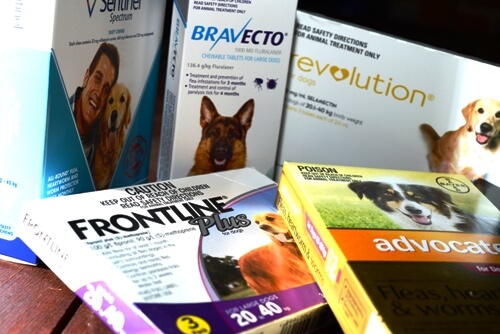Fleas are the most common external parasite of dogs. Even the best-kept dogs can be infested with fleas, especially if they regularly leave their property. Left untreated the infestation quickly becomes a much bigger problem and can lead to other things such as tapeworm infection, anaemia (low red cells in the blood) and skin conditions such as flea allergy dermatitis.
But I bathed the dog
Many dog owners think that simply bathing their dog will solve the problem, but this is not the case. To understand how to truly keep on top of fleas, you first need to understand their lifecycle.
Fleas are a little bit like a mosquito in that they feed on blood. Without a feed of blood, they are unable to mature and lay their eggs. So to the flea, your greyhound is simply a moving restaurant – they jump on, have a feed, leave and then lay their eggs and die. The majority of the flea lifecycle takes place away from the dog – in the bedding, kennels, or even in the carpet of your house if your dogs come inside. So what you see on the dog is only the tip of the iceberg.

How does the dog get fleas in the first place?
Even if your property is completely flea-free, your dogs can become infested if fleas are brought onto the property. This can be via a new dog, through straw-type bedding (often infested from rabbits that live in hay sheds), or from yours or the neighbour’s cat that has been off wandering and has picked up a few fleas on their travels. Dogs, cats and rabbits all share the same fleas. Your dog may also pick up fleas when off your property.
The flea simply jumps onto the dog as it goes past. Once on the dog, the flea will usually head towards the rear, often spending most of the time in the hair above the base of the tail. This is why the best place to look for fleas is in this area, or in the less hairy parts of the dog such as the belly area or inside the thighs. Seeing fleas with the naked eye can be hard as they don’t like light, so if you part the dog’s hair the fleas will scramble into the dark areas.
Sometimes the only thing you will see is ‘flea-dirt’. This is simply the waste matter the flea passes out after digesting its meal. Flea dirt looks like normal grains of dark dirt in the coat, but if you wet it, it dissolves and turns a reddish colour. Similarly, if you are bathing the dog, and the water hits the flea dirt, it will turn into a reddish stain. If there is flea dirt, there are fleas, whether you can see them or not.
What happens once the flea is on the dog?
Once on the dog, they start feeding. The flea will suck blood from the dog, injecting saliva as they do it. This flea saliva can cause allergic reactions in some dogs, and they will quickly start to bite and scratch at themselves – similar to a person who is allergic to mosquito bites. This can lead to severe coat problems, dermatitis, and damage to the skin from biting and scratching.
Once the flea has had its meal of blood, it will start to lay eggs which simply drop off the dog. Each flea can lay hundreds of eggs, and these eggs can survive in the environment for quite a long time (even years) and are quite hard to kill. Because the eggs drop off the dog, common places for egg infestation are bedding, resting areas, and kennels – all places where dogs spend a lot of time.
Hatching of the eggs occurs when the temperature and humidity is right. The hatching can also be triggered by vibration. This explains why people who move into an empty house that has previously had pets often end up with flea bites – their movement triggers the eggs to hatch and the fleas have no pets to jump onto, and end up biting the people instead!
Flea eggs hatch into larva, which look similar to a microscopic maggot. They are not as tough as the eggs, and need warm, humid conditions to mature. The larvae then spin a little cocoon for themselves and turn into the next lifecycle stage – the pupae. The pupae can survive for months before hatching into adult fleas, so even if you think you have got rid of all the adult fleas, you will still have pupae waiting to hatch when the conditions are right.
How long does it take?
The whole lifecycle of the flea – from adult to eggs to adult can take as little as 2 weeks in the warm, humid months, meaning one flea can turn into hundreds which can turn into thousands in under a month! That is why flea problems tend to be worst in the spring and summer months when the weather is just right.
What should I do to keep my dogs flea-free?
Only 5% of the flea problem is adult fleas on the dog, so the only way to be successful in controlling fleas is to address the environmental infestation as well. In the past, people used flea combs to remove the adult fleas from the dog’s coats, but when the dog goes back to its kennel it gets re-infested.
Similarly, bathing the dog with a flea shampoo, or using a flea rinse will certainly kill the fleas on the dog at the time of the bath and rinse them from the coat, but it will do nothing to stop the dog becoming re-infested. Add to this, many of the ‘old-fashioned’ flea rinses are quite toxic, and there is little point to using them if you want to truly solve the problem.
These days there are many ‘spot-on’ products that not only kill the fleas on the dog when applied, but go on working to kill the fleas for up to a month. This can work quite well as you are basically using the dog to clean the environment – the eggs hatch, the fleas jump on and die, no new eggs are laid. The environmental store of eggs gradually all hatch and you end up with reduced environmental contamination. There are also products that have an added ingredient that stops the eggs from hatching. The product crystallizes and small crystals fall off into the dog’s bedding and elsewhere, causing any eggs there to become sterile.
Finally, addressing the environmental contamination can also reduce the burden. Regularly vacuuming carpets will remove eggs, but remember to empty the vacuum bag into the bin as the eggs will still be alive in the bag. Regularly washing dog blankets and bedding in hot (>60Oc) water for more than 10 minutes, or completely replacing carpet used in the kennels will also keep the environment cleaner. Avoid giving your dogs access to areas such as under the house, where the humidity and temperature are right for a fast flea lifecycle and where cleaning is almost impossible.
Finally, make sure that any new dogs coming onto your property are treated for fleas. Treating the arriving dogs yourself with a good quality flea product will ensure you keep the fleas away. Ask your veterinarian for advice on which products would best suit your greyhound.
For more information about Greyhound Care and Standards, click here.


